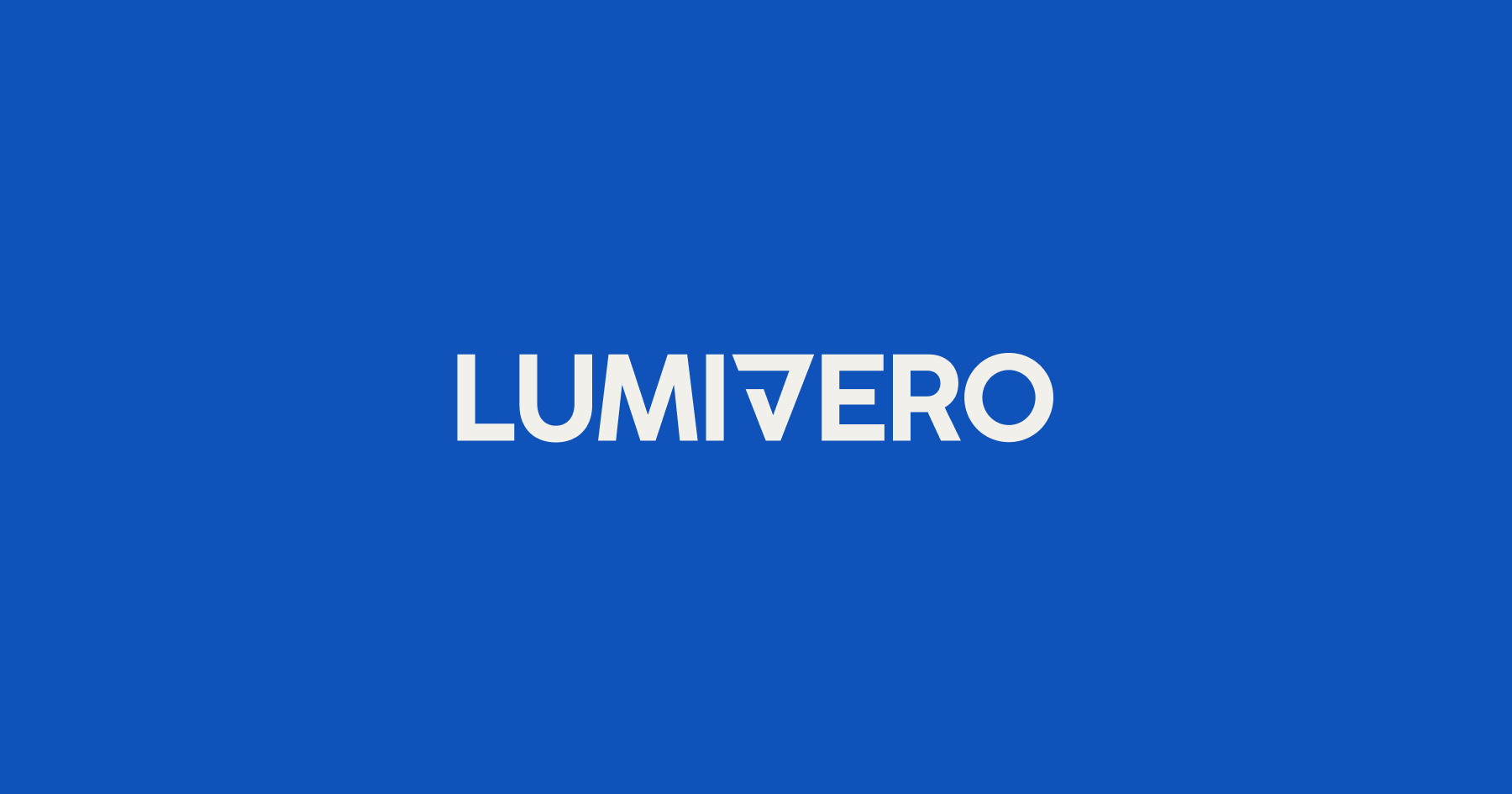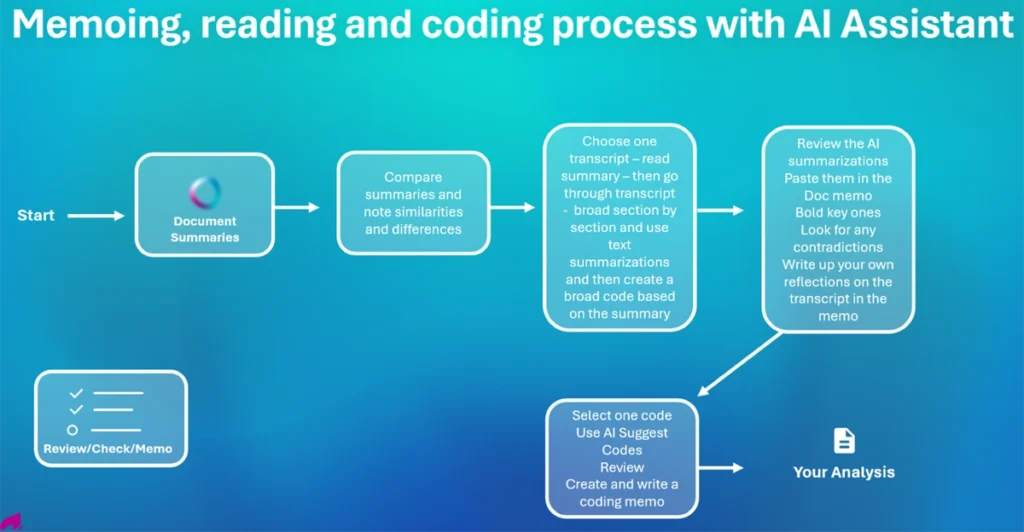
Since its debut in 2022, OpenAI’s ChatGPT has sparked widespread adoption of generative artificial intelligence (AI) across various industries – from marketing and media to software development and healthcare. This transformative technology is now poised to elevate the field of qualitative data analysis and QDA software.
With the release of NVivo 15, we introduced the cutting-edge Lumivero AI Assistant to our powerful qualitative data analysis software (QDA software). Developed with input from our AI advisory board, the Lumivero AI Assistant offers researchers powerful tools for enhancing their qualitative analysis while maintaining researcher control, data security, and methodological transparency.
In a recent webinar, Dr. Silvana di Gregorio, Lumivero’s Product Research Director and Head of Qualitative Research, walked through how we developed the Lumivero AI Assistant for NVivo 15 and demonstrated how it works in practice for memoing and coding qualitative research data.
Watch the webinar or continue reading to learn more!
Qualitative Data Analysis and Technological Innovation Go Hand-in-Hand
Dr. di Gregorio has been working with and on qualitative data analysis software since 1995. At the beginning of the webinar, she took time to remind attendees that qualitative research has always embraced new technology.
“[Qualitative research is] constantly evolving, and that evolution has been always intertwined with technology,” said Dr. di Gregorio.
However, Dr. di Gregorio also noted that qualitative research methodologists have often taken a cautious approach to incorporating new technologies into their practices. “There’s always been kind of a lag between influencers and technology,” she said.
Dr. di Gregorio cited the adoption of the tape recorder as one example of how new technology impacted research practices: prior to the wide availability of inexpensive tape-recording equipment, most data for qualitative analysis was drawn from notes, letters, diaries and other written material. Recording technology enabled the spoken word to be captured and opened a new world of conversational analysis that led to richer insights.
Over the last 30 years, QDA software has played a similar role by enabling researchers to analyze data source materials, including interviews, and develop code structures to describe the data that’s present in those materials. Most QDA software, including previous versions of NVivo, has also integrated early machine learning- or AI-based features such as speech-to-text transcription or sentiment analysis. In all these instances, new technology has been seen as a tool rather than a threat.
“We use tools to manage limitations of our brain power,” Dr. di Gregorio explained. “In relation to qualitative data and analysis, the problems we are trying to solve are how to manage and organize unstructured data or very rich, in-depth data . . . and how to find patterns in that data.”
Even though generative AI seems to have tremendous disruptive potential, Dr. di Gregorio described it as yet another addition to the researcher’s toolbox – not a replacement for qualitative researchers themselves.
However, just like a physical tool in a workshop, AI needs to be used responsibly.
Guided by Expertise: The AI Advisory Board’s Impact on the Lumivero AI Assistant for NVivo 15
AI tools need to be carefully integrated into research. A January 2024 article in BMC Medical Ethics about the ethical challenges of using AI in healthcare, for example, describes the need to look beyond “the allure of innovation” and ensure that the use of AI benefits all stakeholders.
Qualitative research, like healthcare, has ethical standards that need to be maintained. Incorporating AI in qualitative research carelessly could erode those standards. With this in mind, our team convened an AI Advisory Board to inform and guide the development of NVivo 15 with the Lumivero AI Assistant. Dr. di Gregorio described the diverse makeup of the board as including researchers at every career stage, from PhD candidates to seasoned academics, as well as members drawn from nonprofit and commercial organizations. “Everyone was totally engaged in this process,” explained Dr. di Gregorio.
Insights from the AI Advisory Board led to the development of three pillars guiding our team’s approach to AI. These include:
- Researcher autonomy and control: The Lumivero AI Assistant does not “do” qualitative research analysis. It’s a tool that helps researchers streamline their evaluating and coding process and allow for in-depth analysis. Researchers are always in control of the output.
- No black boxes: Researchers have full transparency and observability of what data the Lumivero AI Assistant is using to generate a summary or suggest a code.
- Data security and privacy: Lumivero has a zero-data retention policy agreement with OpenAI. This means that any data analyzed by the Lumivero AI Assistant is not used by OpenAI for training future versions of its large language model (LLM). Furthermore, data is not stored on OpenAI’s servers. It’s deleted once the AI Assistant has completed its summary or analysis.
The AI Advisory Board’s insights also helped refine details of how the Lumivero AI Assistant functioned. For example, when summarizing text, the advisory board came to a consensus that summaries should use the third-person voice instead of the first-person voice. This would prevent the excerpts being mistaken for direct quotes.
The advisory board also decided that researchers should be able to control the automatic coding feature – they could choose whether to let the AI Assistant only suggest codes to the researcher with the researcher doing the actual coding or to allow the AI Assistant to do the coding as well.
Memoing Made Smarter for Better Qualitative Analysis
Dr. di Gregorio transitioned into a practical demonstration, showing how the Lumivero AI Assistant enhances memoing for qualitative researchers.
She began by revisiting the various types of memos used in qualitative research, referencing the work of Paul Mihas, a qualitative research expert (1) at the Odum Institute for Research in Social Science at the University of North Carolina at Chapel Hill. In the description of a memoing course Mihas taught for the ResearchTalk consultancy, Mihas emphasized that "memo-writing strategies help us develop abstract thinking, discern inscribed meaning between pieces of data, and assess collective evidence for emerging claims,” a concept central to the memoing process Dr. di Gregorio explored.
Dr. di Gregorio demonstrated how to revitalize the process of creating what Mihas calls “document reflection” memos using the Lumivero AI Assistant in NVivo 15. A document reflection memo, Dr. di Gregorio explained, “is when you're getting an initial understanding of a transcript or text and try to capture, at a high level, the takeaways – the pivotal moments of what's going on there.”
Real-World Example of Using Qualitative Data Analysis Software with AI
To illustrate the practical application of this approach, Dr. di Gregorio utilized real-world data from a past research project, offering a hands-on demonstration of how the Lumivero AI Assistant can be employed for document reflection memos.
For her demonstration, she selected data from a University of London mixed methods study conducted more than a decade ago which explored the differences in how 16- to 18-year-olds in Europe perceived community responsibility and political engagement. The study aimed to determine whether these opinions varied based on the post-compulsory secondary education pathways they pursued.
First, Dr. di Gregorio used the Lumivero AI Assistant to generate overall summaries of each transcript which were saved as memos linked to each transcript. Next, she went through the transcripts one at a time, using the Lumivero AI Assistant to summarize individual sections. These were saved as annotations within the project and were clearly labeled as having been AI-generated. Dr. di Gregorio was then able to quickly assign broad codes to each annotated section of the transcript based on the Lumivero AI Assistant’s suggestions.
Having completed a high-level summary of the transcript along with preliminary coding, she was then able to dig deeper into the data. Working through each annotation, she reviewed the section of the transcript from which it was generated. She was then able to add the annotations to the memos, drawing out deeper themes from what the interview subject was saying – what Mihas calls a “key quotation memo” – and adding selected quotes as well as her own thoughts on the developing analysis.
She then reviewed the broad codes she created and used Lumivero’s AI Assistant to suggest child codes (sub-codes) refining the analysis. She created a code memo for each code to review the code across all the transcripts.
The process is summarized in the figure below:

Dr. di Gregorio explained that while qualitative data analysis software of the past has always included memoing tools along with coding tools, the memoing features have typically been difficult to find or researchers jumped to coding immediately. NVivo 15 with Lumivero AI Assistant is designed to help bring memoing back into balance with coding and can be used with all approaches to qualitative methods such as thematic analysis, discourse analysis, narrative analysis and more!
Dr. di Gregorio also noted that NVivo 15’s Lumivero AI Assistant also supports researchers with additional features. These include:
- Summaries of foreign-language documents: Researchers can generate a summary in their own language for a source document or transcript created in a different language.
- Quick lookup of unfamiliar terms and names: Highlighting a term mentioned in a transcript or source document immediately pulls up a definition or other explanatory resource for additional context. This definition can be saved as an annotation in the NVivo project.
- Customizable summaries: Researchers can specify whether they want the Lumivero AI Assistant to generate short or long summaries.
Also, if the researcher feels the summary doesn’t accurately reflect the text they’ve highlighted, they can ask the Lumivero AI Assistant to re-summarize. With NVivo 15, the researcher is always in control.
Richer Reflexive Analysis with NVivo 15
Better memoing capabilities enable researchers to conduct richer reflexive analysis. The authors of “A Practical Guide to Reflexivity in Qualitative Research,” a 2023 article in the journal Medical Teacher describe reflexivity as the process “through which researchers self-consciously critique, appraise, and evaluate how their subjectivity and context influence the research processes.”
Dr. di Gregorio showed how researchers can use the Lumivero AI Assistant within NVivo 15 to create annotations and memos quickly. Within the memos, researchers can identify not just the themes of the data, but also how the data was gathered.
For example, researchers can create positional memos that notate how the social power dynamics between interviewer and interviewee or the circumstances of an interview might influence the conversation. These reflexive observations can then be included in the final research product – giving crucial context and transparency to audiences who will read and apply the research.
Finally, Dr. di Gregorio noted that researchers need to be transparent about how they use AI tools within qualitative research, being sure to emphasize that AI supports analysis rather than conducting it.
“When you're writing up any methodological section, whether it's a dissertation or whether it's an article for publication, [be] clear about the process of how you did it. NVivo doesn't do the analysis. You are still doing the analysis, but you're using [AI] as an aid,” said Dr. di Gregorio.
Experience the Advantages of Qualitative Research Software with AI
Ready to transform your workflow, gain deeper insights into your research question, and streamline your analysis? Don’t wait—request your free demo of NVivo 15 and the Lumivero AI Assistant and discover the next level of qualitative research innovation.
Reference
Mihas, Paul Memo Writing Strategies: Analyzing the Parts and the Whole in Vanover, C., Mihas, P, Saldana, J. (2022) Analyzing and Interpreting Qualitative Research: After the Interview, Sage Publications
